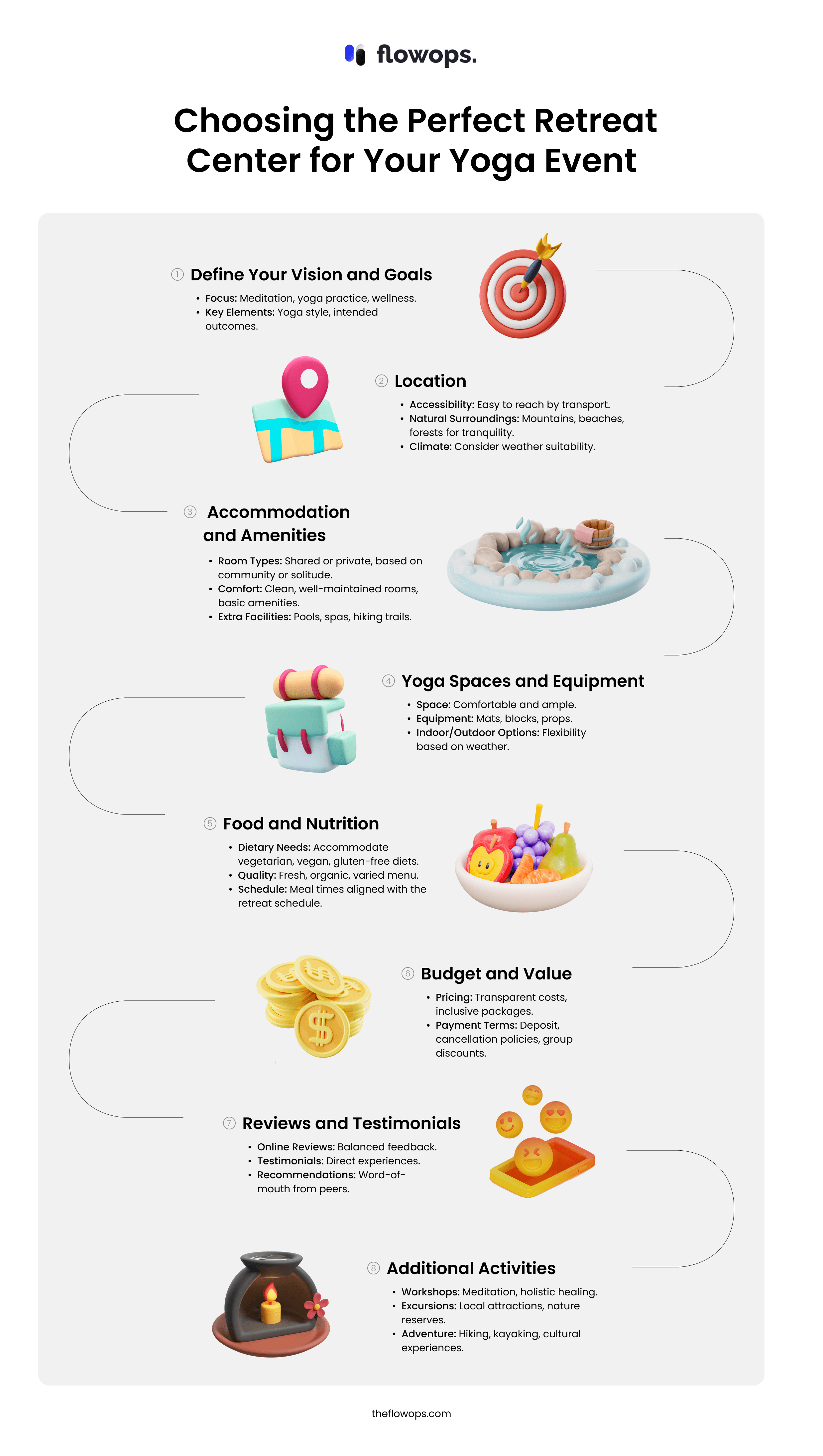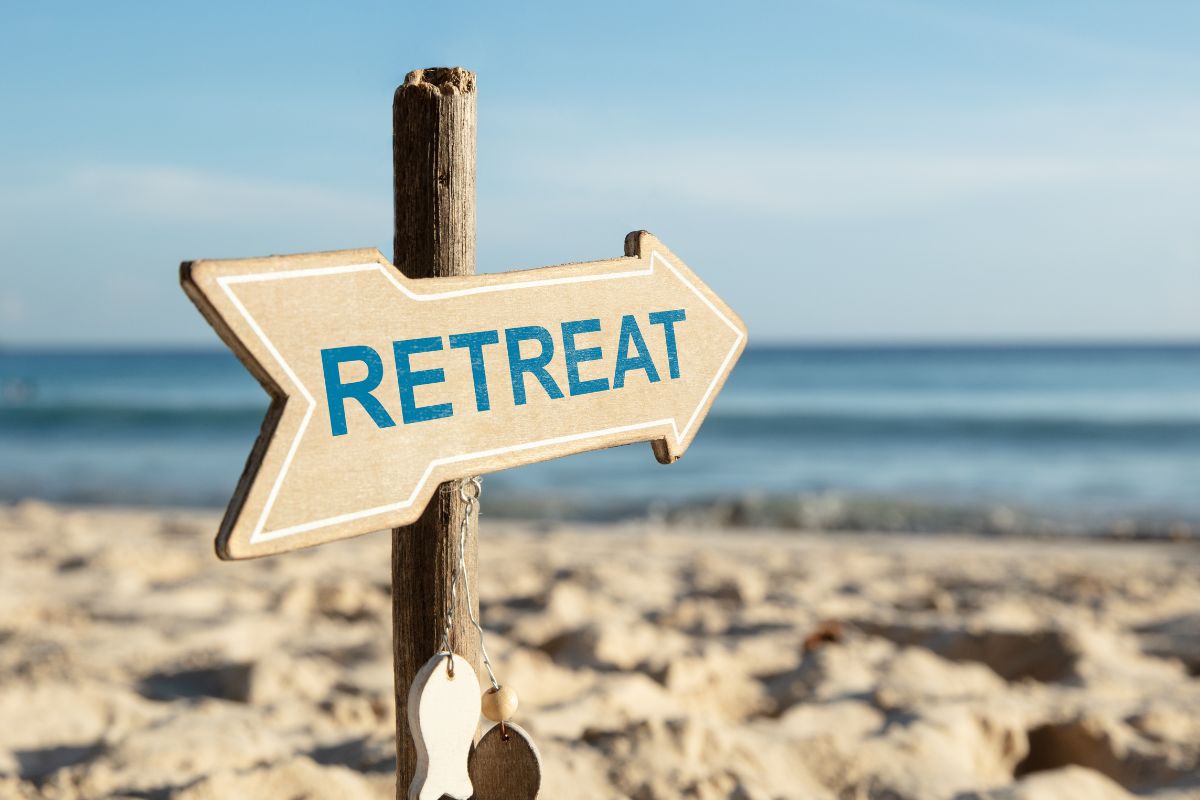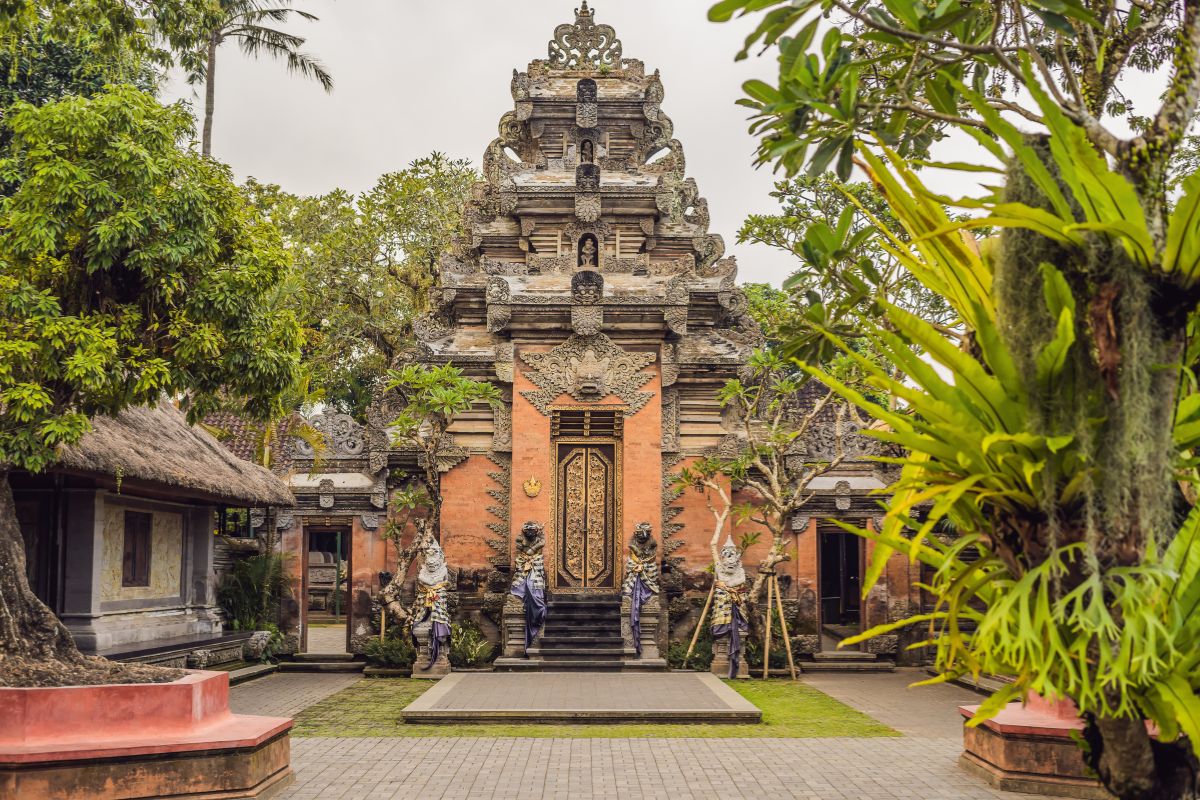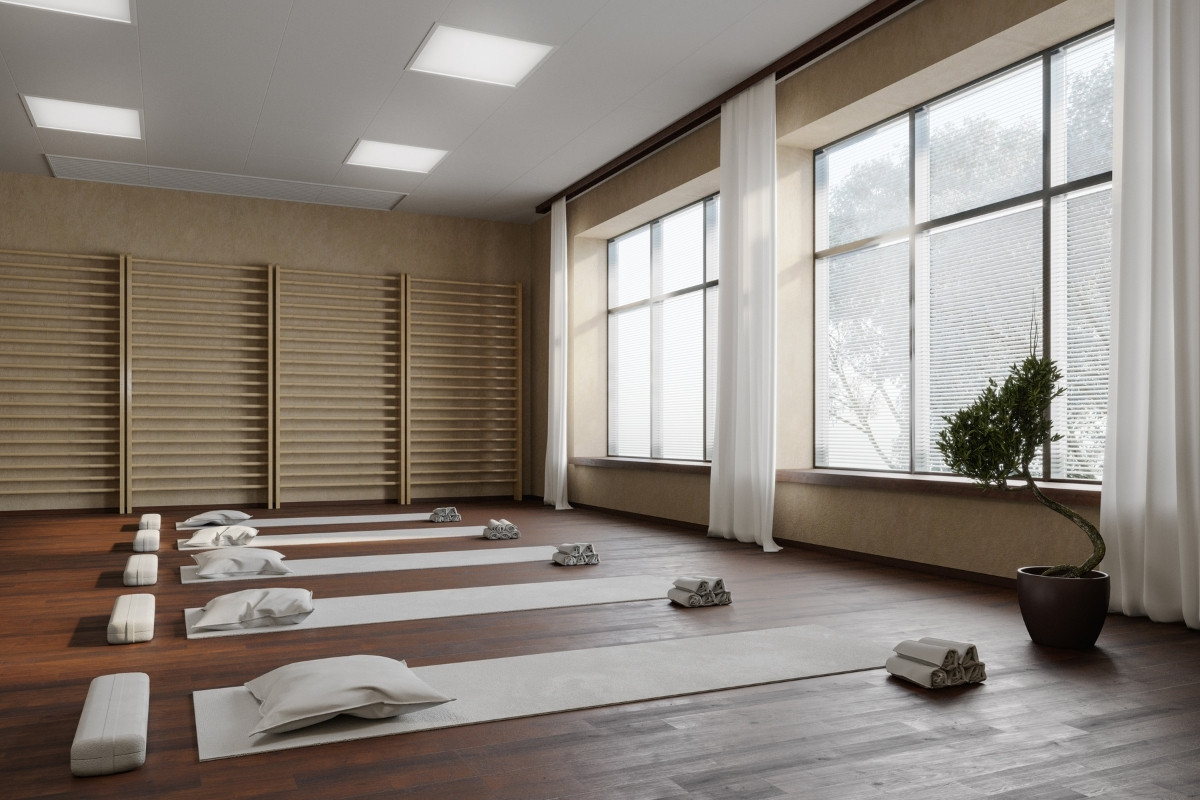Selecting the right yoga retreat center is a crucial yet often overlooked aspect of organizing a yoga retreat.
While it might be tempting to opt for a standard AirBnB or hotel to stay within budget, the right venue can significantly enhance the experience and help you accomplish more with less.
The perfect retreat center provides the ideal backdrop for relaxation, growth, and rejuvenation.
Here’s a comprehensive guide to help you choose a venue that will elevate your yoga event and support your vision.
1. Define Your Vision and Goals
Before starting your search for a venue, clarify the purpose and goals of your retreat. Consider what key takeaways you want participants to gain. For example, are you focusing on deep meditation, intensive yoga practice, or a blend of wellness activities? Do you want them to understand the importance of daily movement to prevent injuries, or master the fundamentals of handstands for home practice? Defining these specific outcomes will help you identify the facilities and ambiance needed to support your retreat’s objectives.
- Intended Outcomes
Consider what you want participants to take away from the retreat. Is it spiritual growth, physical health, or a sense of community? Your goals will guide your choice of location and amenities.
- Yoga Style
Different styles of yoga may require specific environments. For instance, a restorative yoga retreat might benefit from quiet, intimate spaces, while a Vinyasa retreat could require a larger, well-ventilated room.
If your retreat emphasizes advanced Ashtanga yoga, you’ll need a center with a well-equipped yoga studio, preferably with heated flooring and plenty of space for movement. Conversely, a retreat focused on relaxation and rejuvenation might prioritize serene surroundings and spa facilities.
2. Location, Location, Location

The location sets the tone for your retreat, influencing the atmosphere, accessibility, and overall experience. Choosing the right location requires balancing several factors to create an environment conducive to relaxation, practice, and community.
- Accessibility
Is the retreat center easily reachable by road, air, or public transport? Ensure it’s convenient for your participants to get there without undue stress. A remote location might offer tranquility but could be a logistical challenge.
- Natural Surroundings
Nature plays a crucial role in the yoga experience. Look for serene environments like mountains, forests, beaches, or countryside settings that enhance the sense of peace and relaxation. Natural beauty can significantly enhance the meditative and reflective aspects of your retreat.
- Climate
Check the weather conditions during your planned dates. An outdoor retreat in a tropical location might be ideal in dry seasons but challenging during monsoon periods. Consider how the climate will impact your planned activities.
Imagine, a beachfront retreat in Bali that offers tranquility and a scenic backdrop, perfect for sunrise yoga sessions and evening meditations by the ocean. Alternatively, a mountain retreat in the Swiss Alps could provide a stunning, crisp environment ideal for invigorating morning practices and reflective evening sessions.
3. Accommodation and Amenities
Comfortable accommodation is key to ensuring your participants can unwind and rejuvenate. The quality of their living arrangements directly impacts their overall experience and ability to fully immerse in the retreat.
- Room Types
Decide whether you need shared or private rooms by considering the preferences and budget of your target audience.
For example, are your participants budget-conscious or more price-insensitive, such as executives from large corporations?
Shared accommodations can foster a sense of community, while private rooms may appeal to those seeking solitude and personal space. Ensure your retreat packages reflect their needs and preferences.
- Comfort and Cleanliness
The rooms should be clean, well-maintained, and comfortable. Basic amenities like hot water, heating, or air conditioning can significantly impact the experience. Ensure that the accommodation matches the level of comfort your participants expect.
- Additional Facilities
Look for retreat centers that offer amenities such as swimming pools, spas, saunas, or hiking trails, which can enhance the retreat experience.
For example, some venues in Australia feature outdoor hot tubs and private saunas, while others nestled in forests might offer communal domes for yoga practice. These amenities provide added value and give participants enjoyable ways to unwind and make the most of their free time.
A luxury retreat center in the Swiss Alps may offer spa treatments, hot tubs, and guided nature hikes, enhancing the overall wellness experience.
On the other hand, a simpler eco-retreat in Costa Rica might offer rustic but comfortable lodgings that emphasize a close connection with nature.
4. Yoga Spaces and Equipment

The yoga practice area is the heart of your retreat. A well-designed and adequately equipped space can significantly enhance the overall experience for participants. Ensure it meets your needs by considering:
- Space and Layout
The yoga studio should comfortably accommodate your group. Consider the layout, natural lighting, and ventilation. Ample space ensures that participants have enough room to practice without feeling crowded.
- Yoga Props
Look for retreat centers that offer amenities like swimming pools, spas, saunas, or hiking trails to enhance the retreat experience. For instance, some venues in Australia feature outdoor hot tubs and private saunas, while others in forest settings might have communal domes for yoga practice.
These amenities add value and provide participants with enjoyable ways to unwind during their free time. To simplify your search, use the FlowOps web app, which allows you to filter retreat venues based on the availability of these amenities.
- Indoor and Outdoor Options
Some centers offer both indoor studios and outdoor platforms, providing flexibility depending on the weather and the type of session. Outdoor spaces can offer a unique connection to nature, enhancing the yoga experience.
A retreat center in Costa Rica might offer an open-air yoga shala surrounded by lush jungle, perfect for immersing in nature while practicing. Alternatively, a center in a colder climate like Canada might provide a cozy, heated indoor studio with large windows overlooking a snowy landscape.
5. Food and Nutrition
Nutritious and delicious meals are vital for maintaining energy levels and supporting a holistic experience. The quality and variety of food provided can greatly influence the satisfaction and well-being of your participants. Evaluate the food offerings based on:
- Dietary Needs
Ensure the center can accommodate various dietary requirements like vegetarian, vegan, gluten-free, or other special diets. The ability to cater to diverse needs shows a center’s commitment to inclusivity and participant well-being.
- Quality and Variety
The food should be fresh, organic, and locally sourced whenever possible. A varied menu keeps meals exciting and satisfying. Quality nutrition supports the physical demands of yoga practice and overall health.
- Meal Schedules
Check if the meal times align with your retreat schedule. Some centers might offer flexibility to match your program’s needs. Regular, well-timed meals ensure participants remain nourished and energized throughout the day.
A retreat center in Thailand might provide a menu rich in fresh fruits, vegetables, and traditional Thai dishes, catering to both vegetarian and vegan preferences. A Mediterranean retreat might offer a variety of fresh seafood, locally grown vegetables, and heart-healthy olive oil.
Meals that nourish and elevate the retreat.
From gluten-free to plant-based, our guide helps you craft menus as intentional as your classes.

6. Budget and Value

Balancing cost and value is crucial when selecting a retreat center. You want to ensure that the investment you make provides a worthwhile experience for both you and your participants. Consider the following aspects to strike the right balance:
- Transparent Pricing
Ensure you understand what’s included in the price. Some centers offer all-inclusive packages, while others charge separately for meals, yoga sessions, and additional activities. Transparency in pricing helps avoid unexpected costs.
- Payment Terms
Check the deposit requirements, cancellation policies, and payment schedules. These can impact your financial planning. Flexible payment terms can provide peace of mind in case of unforeseen changes.
- Group Discounts
Inquire about discounts for large groups or early bookings, which can help reduce overall costs. Negotiating group rates can make the retreat more affordable for participants.
A budget-friendly retreat center in Mexico might offer excellent facilities and meals at a fraction of the cost compared to more popular destinations, making it accessible for more participants. On the other hand, a high-end retreat center in the Maldives might offer unparalleled luxury at a higher price point.
7. Reviews and Testimonials
Research feedback from previous visitors to gauge the retreat center’s reputation. This step is crucial for understanding the quality and reliability of the center. Look for:
- Online Reviews
Check platforms like TripAdvisor, Google, or specialized retreat review sites. Pay attention to both positive and negative feedback to get a balanced view. Positive reviews can affirm the quality of the center’s amenities and services, while negative reviews can highlight areas of concern or common issues that might affect your decision.
- Testimonials
Read testimonials on the center’s website or ask the center for references. Direct testimonials can provide insights into the experiences of past participants, offering personal accounts of the retreat’s impact.
- Word of Mouth
Seek recommendations from fellow yoga instructors or participants who have attended similar retreats. Personal recommendations can often be more reliable than online reviews.
A highly-rated retreat center in Portugal might have glowing reviews highlighting its serene environment, excellent yoga instructors, and top-notch facilities. Negative reviews might provide insight into potential drawbacks, helping you make an informed decision.
8. Additional Activities and Excursions

Enhance your retreat with additional activities that complement yoga practice. These activities can enrich the overall experience, providing participants with opportunities for relaxation, adventure, and personal growth. Consider incorporating the following:
- Workshops
Offer workshops on meditation, Ayurveda, or holistic healing. These sessions can provide deeper insights into practices that support wellness, helping participants integrate new techniques into their daily lives and enriching their overall retreat experience.
- Excursions
Plan outings to local attractions, nature reserves, or cultural sites. These activities can offer participants a refreshing break from the daily routine, allowing them to explore and appreciate the surrounding environment and local culture.
- Adventure Activities
Include activities like hiking, kayaking, or horseback riding to add variety and excitement to the retreat. These physical activities can complement the yoga practice by promoting overall fitness, encouraging exploration, and enhancing the participants’ sense of adventure.
A retreat in Australia might include guided treks through stunning landscapes, offering a blend of yoga and adventure. A retreat in India might offer cultural excursions to local temples and markets, providing a rich, immersive experience.
Time to Choose Wisely
Selecting the ideal retreat center for your yoga event involves careful consideration to balance various factors and create a harmonious and enriching experience.
By defining your vision, prioritizing comfort and convenience, and ensuring the right amenities and atmosphere, you can design a memorable retreat that resonates deeply with your participants.
As you go through your options in various retreat booking sites, it is also good to take the time to research and, if possible, visit potential centers. To streamline your search, use The FlowOps to find and filter retreat venues that align with your needs and preferences. Trust your intuition to find the perfect match for your yoga event.
Selecting the ideal retreat center is more than just picking a location; it’s about creating an environment where transformation and growth can flourish. By following these guidelines, you can ensure that your retreat provides a supportive, enriching, and unforgettable experience for all who attend.
If you’re looking for more tips on how to host a memorable yoga retreat, here are some of our tips!
Ready to turn your retreat vision into reality?
The FlowOps makes it easy to bring all the pieces together — from building a beautiful, mobile-ready website to scheduling sign-ups for classes, 1:1s, and retreat spots.
Start for free and explore how we can support your next retreat—every step of the way.



